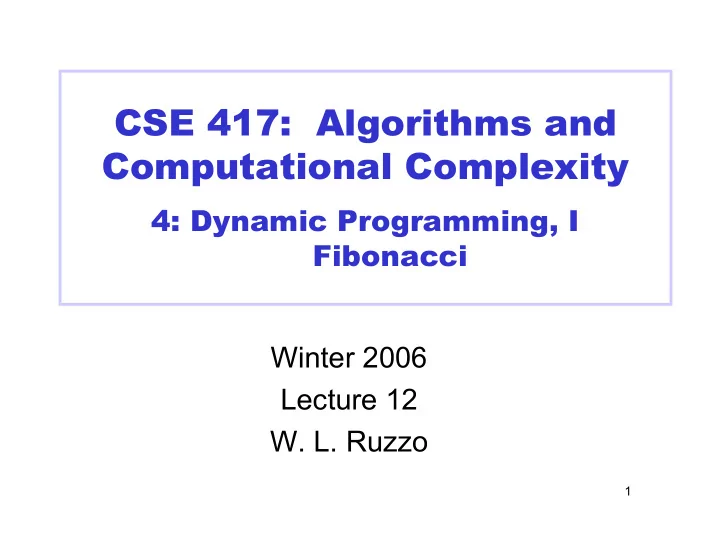

CSE 417: Algorithms and Computational Complexity 4: Dynamic Programming, I Fibonacci Winter 2006 Lecture 12 W. L. Ruzzo 1
Some Algorithm Design Techniques, I • General overall idea – Reduce solving a problem to a smaller problem or problems of the same type • Greedy algorithms – Used when one needs to build something a piece at a time – Repeatedly make the greedy choice - the one that looks the best right away – e.g. closest pair in TSP search – Usually fast if they work (but often don't) 2
Some Algorithm Design Techniques, II • Divide & Conquer – Reduce problem to one or more sub-problems of the same type – Typically, each sub-problem is at most a constant fraction of the size of the original problem • e.g. Mergesort, Binary Search, Strassen’s Algorithm, Quicksort (kind of) 3
Some Algorithm Design Techniques, III • Dynamic Programming – Give a solution of a problem using smaller sub-problems, e.g. a recursive solution – Useful when the same sub-problems show up again and again in the solution 4
“Dynamic Programming” Program — A plan or procedure for dealing with some matter – Webster’s New World Dictionary 5
A simple case: Computing Fibonacci Numbers • Recall F n =F n-1 +F n-2 and F 0 =0, F 1 =1 • Recursive algorithm: – Fibo(n) if n=0 then return (0) else if n=1 then return (1) else return (Fibo(n-1)+Fibo(n-2)) 6
Call tree - start F (6) F (5) F (4) F (4) F (3) F (3) F (2) F (2) F (1) F (1) F (0) 1 0 7
Full call tree F (6) F (5) F (4) F (4) F (2) F (3) F (3) F (2) F (1) F (3) F (2) F (2) F (1) F (1) F (0) 1 F (1) F (0) 1 1 0 F (2) F (1) F (1) F (0) F (1) F (0) 0 1 1 1 0 1 F (1) 0 F (0) 1 0 8
Memo-ization (Caching) • Remember all values from previous recursive calls • Before recursive call, test to see if value has already been computed • Dynamic Programming – Convert memo-ized algorithm from a recursive one to an iterative one (top-down → bottom-up) 9
Fibonacci - Memo-ized Version initialize: F[i] ← undefined for all i F[0] ← 0 F[1] ← 1 FiboMemo(n): if (F[n] undefined) { F[n] ← FiboMemo(n-2)+FiboMemo(n-1) } return (F[n]) 10
Fibonacci - Dynamic Programming Version FiboDP(n): F[0] ← 0 F[1] ← 1 for i=2 to n do F[i] ] ← F[i-1]+F[i-2] endfor return (F[n]) 11
Dynamic Programming • Useful when – same recursive sub-problems occur repeatedly – Can anticipate the parameters of these recursive calls – The solution to whole problem can be figured out with out knowing the internal details of how the sub-problems are solved • principle of optimality 12
Recommend
More recommend